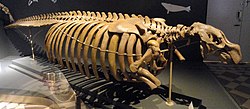
Back بقرة البحر ستيلر Arabic Wekixol (Hydrodamalis gigas) AVK Dəniz inəyi Azerbaijani Марская карова Byelorussian Стелерова морска крава Bulgarian Vaca marina de Steller Catalan Hydrodamalis gigas CEB Koroun bezzubý Czech Stellers søko Danish Stellers Seekuh German
| Steller's sea cow Temporal range: Pleistocene– C. E. 1768
| |
|---|---|

| |
| Skeleton at the Finnish Museum of Natural History | |
| Scientific classification | |
| Domain: | Eukaryota |
| Kingdom: | Animalia |
| Phylum: | Chordata |
| Class: | Mammalia |
| Order: | Sirenia |
| Family: | Dugongidae |
| Genus: | †Hydrodamalis |
| Species: | †H. gigas
|
| Binomial name | |
| †Hydrodamalis gigas (Zimmermann, 1780)
| |

| |
| Map showing the position of the Commander Islands to the east of Kamchatka. The larger island to the west is Bering Island; the smaller island to the east is Copper Island. | |
| Synonyms[2][3][4][5] | |
|
List of synonyms
| |
Steller's sea cow (Hydrodamalis gigas) is an extinct sirenian described by Georg Wilhelm Steller in 1741. At that time, it was found only around the Commander Islands in the Bering Sea between Alaska and Russia; its range extended across the North Pacific during the Pleistocene epoch, and likely contracted to such an extreme degree due to the glacial cycle. It is possible indigenous populations interacted with the animal before Europeans. Steller first encountered it on Vitus Bering's Great Northern Expedition when the crew became shipwrecked on Bering Island. Much of what is known about its behavior comes from Steller's observations on the island, documented in his posthumous publication On the Beasts of the Sea. Within 27 years of its discovery by Europeans, the slow-moving and easily-caught mammal was hunted into extinction for its meat, fat, and hide.
Some 18th-century adults would have reached weights of 8–10 t (8.8–11.0 short tons) and lengths up to 9 m (30 ft). It was a member of the family Dugongidae, of which the 3 m (9.8 ft) long dugong (Dugong dugon) is the sole living member. It had a thicker layer of blubber than other members of the order, an adaptation to the cold waters of its environment. Its tail was forked, like that of whales or dugongs. Lacking true teeth, it had an array of white bristles on its upper lip and two keratinous plates within its mouth for chewing. It fed mainly on kelp, and communicated with sighs and snorting sounds. Steller believed it was a monogamous and social animal living in small family groups and raising its young, similar to modern sirenians.
- ^ Domning, D. (2016). "Hydrodamalis gigas". IUCN Red List of Threatened Species. 2016: e.T10303A43792683. doi:10.2305/IUCN.UK.2016-2.RLTS.T10303A43792683.en. Retrieved 17 February 2022.
- ^ Shoshani, J. (2005). "Hydrodamalis". In Wilson, D.E.; Reeder, D.M (eds.). Mammal Species of the World: A Taxonomic and Geographic Reference (3rd ed.). Johns Hopkins University Press. p. 92. ISBN 978-0-8018-8221-0. OCLC 62265494.
- ^ Wilson, D. E.; Reeder, D. M., eds. (2005). "Hydrodamalis gigas". Mammal Species of the World: A Taxonomic and Geographic Reference (3rd ed.). Johns Hopkins University Press. p. 92. ISBN 978-0-8018-8221-0. OCLC 62265494.
- ^ Palmer, Theodore S. (1895). "The Earliest Name for Steller's sea cow and Dugong". Science. 2 (40): 449–450. doi:10.1126/science.2.40.449-a. PMID 17759916. S2CID 36945810.
- ^ Cite error: The named reference
forstenwas invoked but never defined (see the help page).
© MMXXIII Rich X Search. We shall prevail. All rights reserved. Rich X Search
